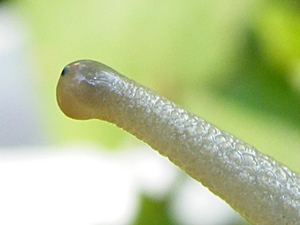Teax
huh?
- Local time
- Today 2:54 AM
- Joined
- Oct 17, 2014
- Messages
- 392
- Location
- in orbit of a friendly star <3
milestone of the off-topic debate with WookieeB from http://intpforum.com/showthread.php?t=20961&page=4.
ID = Intelligent Design
but ID is often associated with creationism.
This thread is about - how reasonable/scientific is the version of ID that has nothing to do with creationism (pure ID so-to-speak), and why.
_________________________
argument for ID reconstructed from that other debate
CSI = Complex and Specified Information.
Complex = Unlikely to happen by chance as a random event.
Specified = necessary to function = if you take it out, the whole system becomes useless/stops working. irreducable complexity.
IC = Irreducably Complex
RM + NS = Random Mutation + Natural Selection (biological theory of evolution)
M + S = Mutation + Selection (mathematical theory behind evolution)
definition of ID:
ID is the search for evidence for ID_statement
ID_statement is the statement/assertion that only intelligence can produce CSI
ID_statement sais: if object has CSI then it has an intelligent designer
notice that this post does not disprove ID_statement, only disproves the popular search for evidence for ID_statement.
ID is made of 3 steps:
step_one:
try to make a case about how all known RM + NS theories cannot explain CSI (even remotely).
in other words: try to make a case that it's extremely unlikely or even impossible that evolution could ever produce CSI.
step_two aka "negative evidence":
if you believe ID is a valid hypothesis(=explanatory theory), then this argument sounds like this: "like with all competing hypothesis in science, if one hypothesis proves unlikely to explain a phenomenon, another hypothesis becomes more likely.".
another version of this argument:
an meta-induction (induction not over objects, but over theories/ideas of people) from step_one, to conclude that future theories will probably never explain CSI
ne_1: All known non-intelligent causes only explain objects without CSI
----this is the premise from step_one
ne_1c: An intelligent-designer-cause can explain objects with CSI
ne_2: For all non-intelligent causes, we infer(induce) from ne_1 that they probably don't explain objects with CSI
----no-bias assertion: <missing>... see below for explanation
ne_2b: All objects with CSI probably have an intelligent cause
----deduction from ne_2 and ne_1c
step_three aka "positive evidence":
pe_1: For all objects with CSI for which we found the cause, ID was always the cause
pe_1b: For all objects for which we found out that the cause was not ID, have no CSI
pe_2: For all objects with CSI, from pe_1 and ne_2b we infer(induce) that they probably have an intelligent cause.
----no-bias assertion: <missing>... see below for explanation
obviously the intelligent design of human life will automatically follow from pe_2
_________________________
flaws
an inference is a conclusion based on a premise
we often use the word 'infer'. but there are 2 basic kinds: deduction and induction.
to understand why ID is a bad argument, you have to first understand: when is induction not valid?
induction: (the no-bias assertion is explained here)
step_one: most interesting point. nothing wrong with questioning evolution theory.
step_two:
looking at ID_statement:
"only an intelligent cause can produce CSI"
this is not a hypothesis. It is a combination of 2 statements:
id_1. "intelligent cause can produce CSI"
id_2. "non-intelligent cause cannot produce CSI"
id_2 is not a hypothesis itself, it's a statement about other ones.
id_1 is a hypothesis, but it is not falsifiable and thus has no predictive power, and thus has no explanatory power. intelligent designer is applicable to everything, even not CSI objects, consequently - disproving other hypothesis, does not give this hypothesis any credence.
note - that doesn't mean that id_1 cannot be proven at all, it just means that it cannot be "proven"(=made reasonable to believe) by "disproving"(=made un-reasonable to believe) other hypothesis.
the other version of this argument is a meta-induction. It's an induction about theories and peoples' ideas, instead of real objects, which is not a valid area for induction. here's the induction in step_two:
note that this kind of meta-induction over theories has the same structure as the god-of-the-gaps-argument saying "since we cannot yet explain it, let's believe a hypothesis with zero explanatory power".
here's an example of a meta-induction:
step_three:
first, notice that pe_1b is equivalent to pe_1, so we can just skip it. step_two cannot be used here since it was not a valid argument. let me remove the refence to ne_2b, we check if step_three has any weight without step_two:
_________________________
conclusion: step_three adds nothing ontop of step two.
In other words: "positive evidence" is not an argument for ID, it is only as believable as the "negative evidence", so there's no point in even stating it.
In other words: the "negative evidence" support of ID remains unchanged, doesn't matter whether you add the "positive edivence" or not. but since "negative evidence" was faulty to begin with, we are left with step_one.

ID = Intelligent Design
but ID is often associated with creationism.
This thread is about - how reasonable/scientific is the version of ID that has nothing to do with creationism (pure ID so-to-speak), and why.
_________________________
argument for ID reconstructed from that other debate
CSI = Complex and Specified Information.
Complex = Unlikely to happen by chance as a random event.
Specified = necessary to function = if you take it out, the whole system becomes useless/stops working. irreducable complexity.
IC = Irreducably Complex
RM + NS = Random Mutation + Natural Selection (biological theory of evolution)
M + S = Mutation + Selection (mathematical theory behind evolution)
definition of ID:
ID is the search for evidence for ID_statement
ID_statement is the statement/assertion that only intelligence can produce CSI
ID_statement sais: if object has CSI then it has an intelligent designer
notice that this post does not disprove ID_statement, only disproves the popular search for evidence for ID_statement.
ID is made of 3 steps:
step_one:
try to make a case about how all known RM + NS theories cannot explain CSI (even remotely).
in other words: try to make a case that it's extremely unlikely or even impossible that evolution could ever produce CSI.
step_two aka "negative evidence":
if you believe ID is a valid hypothesis(=explanatory theory), then this argument sounds like this: "like with all competing hypothesis in science, if one hypothesis proves unlikely to explain a phenomenon, another hypothesis becomes more likely.".
another version of this argument:
an meta-induction (induction not over objects, but over theories/ideas of people) from step_one, to conclude that future theories will probably never explain CSI
ne_1: All known non-intelligent causes only explain objects without CSI
----this is the premise from step_one
ne_1c: An intelligent-designer-cause can explain objects with CSI
ne_2: For all non-intelligent causes, we infer(induce) from ne_1 that they probably don't explain objects with CSI
----no-bias assertion: <missing>... see below for explanation
ne_2b: All objects with CSI probably have an intelligent cause
----deduction from ne_2 and ne_1c
step_three aka "positive evidence":
pe_1: For all objects with CSI for which we found the cause, ID was always the cause
pe_1b: For all objects for which we found out that the cause was not ID, have no CSI
pe_2: For all objects with CSI, from pe_1 and ne_2b we infer(induce) that they probably have an intelligent cause.
----no-bias assertion: <missing>... see below for explanation
obviously the intelligent design of human life will automatically follow from pe_2
_________________________
flaws
an inference is a conclusion based on a premise
we often use the word 'infer'. but there are 2 basic kinds: deduction and induction.
to understand why ID is a bad argument, you have to first understand: when is induction not valid?
induction: (the no-bias assertion is explained here)
an induction is a form of probability argument based on sampling
premise = a sample = sampling space = representative subset of the population
conclusion = prediction about the whole population
induction only works if the premise is representative of the conclusion.
otherwise it's called a bias. if a sample is biased, inductive reasoning is not possible
example:
premise: we randomly pick 20 doors (=sample) in this house and count their locks. all these doors have 2 locks.
conclusion: we infer, all of the doors(=population) in this house have 2 locks.

let's assume the premise is true (we can count to 2, the doors really have 2 locks).
unlike a deduction, an induction is never just true. If it is reasonable to believe the induction, we usually say it's true colloquially, but it's implied that we actually have to call it "probable" or "likely". But it can always be disproven at any time with.....
premise = a sample = sampling space = representative subset of the population
conclusion = prediction about the whole population
induction only works if the premise is representative of the conclusion.
otherwise it's called a bias. if a sample is biased, inductive reasoning is not possible
example:
premise: we randomly pick 20 doors (=sample) in this house and count their locks. all these doors have 2 locks.
conclusion: we infer, all of the doors(=population) in this house have 2 locks.

let's assume the premise is true (we can count to 2, the doors really have 2 locks).
unlike a deduction, an induction is never just true. If it is reasonable to believe the induction, we usually say it's true colloquially, but it's implied that we actually have to call it "probable" or "likely". But it can always be disproven at any time with.....
- ....a counterexample. once the unknown becomes known, it can always disprove the induction.
example: once you find a door with 1 lock, the discussion is over.
. - ....a bias. because an induction is an inference based on sampling, any bias that we discover in the sample challenges the induction.
For every challenge, the induction has the burden of proof to show that there is no bias. Otherwise the induction is not applicable to the whole population anymore, and is only applicable to the bias.
bias challenge: find a property of the population that you excluded in your sample. if you additionally find a correlation/dependence(=opposite of independence) between the sample and the excluded property, then the challenge cannot be refuted.
correction: if the challenge cannot be refuted, the induction can be rewritten to apply to only the bias, thus the bias disappears
defence: to refute the challenge, show that your sample is representative of the whole population. in other words: show that the bias is independent from the property that you make a prediction about. once you do that, this particular bias becomes irrelevant for the validity of the induction.
example:
bias challenge: I noticed you only counted the locks on non-red doors. (the random sample didn't include any red doors) this means you cannot infer that all doors have 2 locks, because we have no idea about the number of locks these red doors have.
correction: instead you can only infer that all non-red doors have 2 locks.
defence: every resident in this house is allowed to paint his door however he wants. the color of a door does not have any influence on the number of locks - because you can always repaint any door into any different color, without touching the number of locks, thus proving that the color of the door and the lock count are independent.
challenge has been refuted, the induction is still reasonable.
note that if a bias is known beforehand, making the induction would be pointless, because it would instantly be challenged. That is why it is necessary to assert that there is no (obvious) bias, everytime you make an induction. this is what I mean by "no-bias assertion" in the definition of the ID argument.
step_one: most interesting point. nothing wrong with questioning evolution theory.
step_two:
looking at ID_statement:
"only an intelligent cause can produce CSI"
this is not a hypothesis. It is a combination of 2 statements:
id_1. "intelligent cause can produce CSI"
id_2. "non-intelligent cause cannot produce CSI"
id_2 is not a hypothesis itself, it's a statement about other ones.
id_1 is a hypothesis, but it is not falsifiable and thus has no predictive power, and thus has no explanatory power. intelligent designer is applicable to everything, even not CSI objects, consequently - disproving other hypothesis, does not give this hypothesis any credence.
note - that doesn't mean that id_1 cannot be proven at all, it just means that it cannot be "proven"(=made reasonable to believe) by "disproving"(=made un-reasonable to believe) other hypothesis.
the other version of this argument is a meta-induction. It's an induction about theories and peoples' ideas, instead of real objects, which is not a valid area for induction. here's the induction in step_two:
- ne_1: All known non-intelligent causes only explain objects without CSI
- ne_2: For all non-intelligent causes -> infer(induce) from ne_1 that they don't explain objects with CSI
bias challenge:- the sample is dependant(correlates) on time because the sample only contains theories discovered in the past.
- peoples' ideas are dependant on time
- peoples' ideas are dependant with the explanatory power of the theories.
- => hence the sample is dependant on the explanatory power of the theories. thus this challenge is irrefutable, proving that this induction is definetly wrong. We cannot infer anything about the future of theories from this.
this is the typical bias challenge for meta-induction attempts (inductions about peoples' ideas).
- correction: For all non-intelligent causes in the past, infer(induce) from ne_1 that they don't explain objects with CSI
note that this kind of meta-induction over theories has the same structure as the god-of-the-gaps-argument saying "since we cannot yet explain it, let's believe a hypothesis with zero explanatory power".
here's an example of a meta-induction:
A kid likes saying random numbers. he would just walk all day saying random numbers out loud.
premise: You start listening to the kid. the first 10 numbers are below 100000.
conclusion: you infer(induction) that all subsequent numbers will also be below 100000.
bad induction. the first 10 numbers are the earliest in time = they depend on time. the kid's ideas change over time = depend on time. thus, the numbers the kid will give in the future are dependent on time. We cannot infer anything in this situation through induction alone. This is the same default refutation for all meta-inductions (inductions about peoples' ideas).
premise: You start listening to the kid. the first 10 numbers are below 100000.
conclusion: you infer(induction) that all subsequent numbers will also be below 100000.
bad induction. the first 10 numbers are the earliest in time = they depend on time. the kid's ideas change over time = depend on time. thus, the numbers the kid will give in the future are dependent on time. We cannot infer anything in this situation through induction alone. This is the same default refutation for all meta-inductions (inductions about peoples' ideas).
step_three:
first, notice that pe_1b is equivalent to pe_1, so we can just skip it. step_two cannot be used here since it was not a valid argument. let me remove the refence to ne_2b, we check if step_three has any weight without step_two:
- pe_1: For all objects with CSI for which we found the cause, ID was always the cause
- pe_2: For all objects with CSI, from pe_1 we infer(induce) that they have an intelligent cause.
bias challenge: the sample only contains non-life. because all the object, for which we found the cause, were non-living objects.
correction: For all non-living objects with CSI, from pe_1a we infer(induce) that they probably have an intelligent cause.
notice that we use the corrected version of pe_2 everyday.
_________________________
conclusion: step_three adds nothing ontop of step two.
In other words: "positive evidence" is not an argument for ID, it is only as believable as the "negative evidence", so there's no point in even stating it.
In other words: the "negative evidence" support of ID remains unchanged, doesn't matter whether you add the "positive edivence" or not. but since "negative evidence" was faulty to begin with, we are left with step_one.















